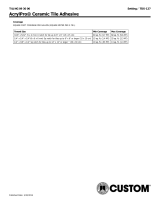
WOOD — Floors, Interior 7
Floors, Interior - Existing Vinyl Floors
Areas of Application
over any even and structurally sound substrate
with existing vinyl flooring
interior dry or wet areas
Limitations
minimum 2" x 2" (50 mm x 50 mm) tile
cushioned vinyl unacceptable
perimeter bonded vinyl flooring unacceptable
multiple layers of vinyl unacceptable
Requirements
for wood substrates, subfloor/underlayment
configuration according to detail DH-W16-T,
DH-W19-T, DH-W24-T, or DH-W-S
Substrate Preparation
ensure that the structure beneath the vinyl is
sound and adequate
ensure that vinyl is well adhered
remove any wax and clean vinyl
for wood substrates, nail off floor with ring
shank flooring nails every 4" (102 mm) o.c. –
fasteners must pass through entire thickness
of assembly with minimal penetration into
joists
any leveling of the subfloor must be done prior
to installing DITRA-HEAT and DITRA-HEAT-
TB.
Movement Joints
DITRA-HEAT and DITRA-HEAT-TB do not
eliminate the need for movement joints,
including perimeter joints, within the tiled
surface. Movement joints must be installed in
accordance with industry standards and
norms; see page 11 of this Handbook, TCNA
EJ171, and TTMAC 301 MJ.
Setting and Grouting Materials
Fast-setting latex portland cement (p.c.)
mortar – ANSI A118.4 or A118.15
unmodified thin-set mortar – ANSI A118.1
grout – ANSI A118.3, A118.6, A118.7, A118.8
Setting and Grouting Specifications
tile – ANSI A108.5
grout – ANSI A108.6, A108.9, A108.10
Other Considerations
DITRA-HEAT and DITRA-HEAT-TB are adhered
to the vinyl flooring using a fast-setting latex-
portland cement mortar suitable for bonding to
vinyl. As an alternative, a suitable cement-
based embossing leveler or an appropriate
latex-modified thin-set mortar can be used to
skim coat the vinyl to provide a bonding
surface. When skim coat is cured, DITRA-
HEAT and DITRA-HEAT-TB are adhered to the
skim coat using an unmodified thin-set mortar.
See page 21 for discussion on latex-modified
thin-set mortars sandwiched between two
impervious layers.
seaming DITRA-HEAT and DITRA-HEAT-TB,
including floor/wall connections, with KERDI-
BAND may be appropriate in cases where a
break in the water line of an ice maker or
dishwasher can damage pre-existing moisture-
sensitive substrates and underlayments.
KERDI-BAND floor/wall connections are just as
easily concealed with wood base as with tile.
KERDI-BAND floor/wall connections in
dishwasher alcoves are parged with thin-set
mortar; see page 10.
vapor barrier on crawl space floors according
to regional building codes.
certain moisture-sensitive stones, e.g., green
marble, or resin-backed tiles may require
special setting materials. Consult stone supplier
and Schluter
®
-Systems for more information.
Floors, Interior - Structural Plank Subfloor
Areas of Application
over structural plank subfloors
interior dry or wet areas
Limitations
minimum 2" x 2" (50 mm x 50 mm) tile
Requirements
maximum spacing of joists is 24" (610 mm) o.c.
double layer wood floor consisting of:
• minimum structural plank subfloor
thickness – 3/4" (19 mm)
• minimum underlayment thickness –
15/32", 1/2" nom. (13 mm)
Substrate Preparation
verify that subfloor planks are properly
fastened to framing members.
underlayment – minimum 15/32", 1/2" nom.
(13 mm)-thick Exposure 1, plugged-face
plywood or OSB with 1/8" (3 mm) gap
between sheets; see page 14 for
underlayment installation guidelines.
any leveling of the subfloor must be done
prior to installing DITRA-HEAT and DITRA-
HEAT-TB.
Movement Joints
DITRA-HEAT and DITRA-HEAT-TB do not
eliminate the need for movement joints,
including perimeter joints, within the tiled
surface. Movement joints must be installed in
accordance with industry standards and
norms; see page 11 of this Handbook, TCNA
EJ171, and TTMAC 301 MJ.
Setting and Grouting Materials
latex portland cement (p.c.) mortar –
ANSI A118.11
unmodified thin-set mortar – ANSI A118.1
grout – ANSI A118.3, A118.6, A118.7, A118.8
Setting and Grouting Specifications
tile – ANSI A108.5
grout – ANSI A108.6, A108.9, A108.10
Other Considerations
vapor barrier on crawl space floors according
to regional building codes.
where a waterproof floor is required, all
DITRA-HEAT and DITRA-HEAT-TB seams
and floor/wall transitions must be sealed with
KERDI-BAND using unmodified thin-set
mortar; see page 10.
certain moisture-sensitive stones, e.g., green
marble, or resin-backed tiles may require
special setting materials. Consult stone
supplier and Schluter
®
-Systems for more
information.
DH-SP-TS-17
DH-V-T-17
Tile or wood base
Ceramic, porcelain
or stone tile
RONDEC
DILEX-EKE
Unmodified thin-set mortar
KERDI-BAND
DITRA-HEAT
or DITRA-HEAT-TB
uncoupling membrane
and heating cables
Fast-setting
latex p.c. mortar
Existing vinyl
Plywood or OSB
Joists, I-joists, or
trusses
Ceramic, porcelain
or stone tile
Unmodified thin-set mortar
DITRA-HEAT
or DITRA-HEAT-TB
uncoupling membrane
and heating cables
Latex p.c. mortar
Plywood or OSB
underlayment
Structural plank
subfloor
Joists






















